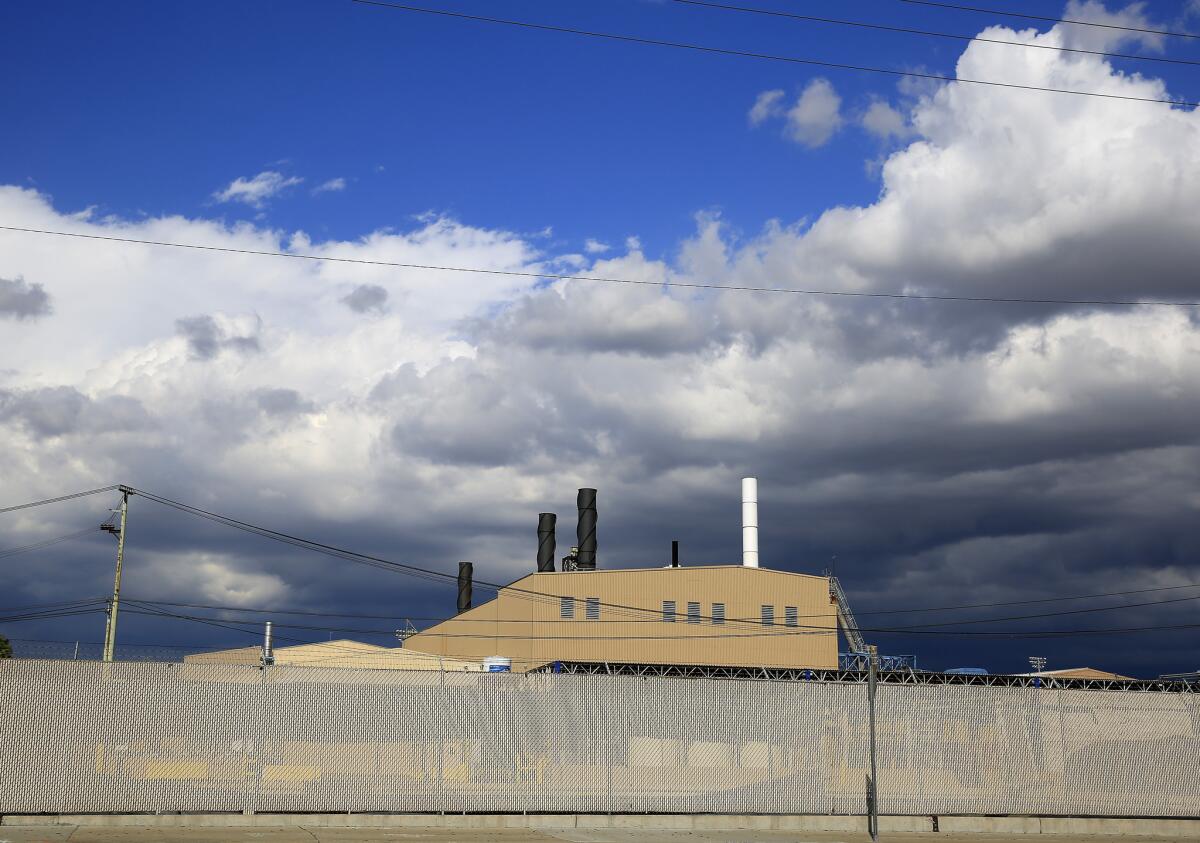Editorial: Why does affluent Porter Ranch get more urgent environmental relief than working-class Boyle Heights?

View of the Exide Technologies battery recycling plant in Vernon.
- Share via
Two Los Angeles communities. Two environmental nightmares. Two very different responses from Gov. Jerry Brown.
At Porter Ranch, where a massive natural gas leak has forced thousands of affluent residents to relocate, Brown has declared a state of emergency, ordered public health reviews and visited residents. But he’s been absent from the Exide environmental debacle across town. In working-class Boyle Heights, Maywood, Huntington Park, Commerce and other communities, residents are still living in fear after state toxics officials warned last year that their yards and homes may be contaminated with high levels of lead that can cause learning disabilities and behavioral problems in children and miscarriages in pregnant women.
Does Brown understand the need for urgency?
Despite the risks facing residents in Exide’s shadow, Brown’s administration continues to move at a sluggish bureaucratic pace to test and clean up the contamination. The state Department of Toxic Substances Control issued the earliest warnings nearly two years ago that dozens of homes near the now-closed battery recycling plant had unsafe levels of lead. Additional tests revealed that the contamination was widespread, and last August, the department said that as many as 10,000 additional homes could be tainted. Yet, to date, only 191 homes have been cleaned up. No families have been relocated. Meanwhile, thousands of residents in the area have been told to keep their children from playing in the dirt and to avoid eating fruits or vegetables that touch the soil.
One problem is money. The DTSC has rightfully chosen to spend public dollars to accelerate the investigation and clean up the lead contamination now, and try to recoup the money from Exide later. (Exide denies that it is responsible for all the lead contamination and a long legal fight is expected.) But the amount set aside so far is a tiny fraction of what’s needed. In August, state lawmakers gave the DTSC $7.7 million, enough to test 1,500 properties and clean up about 50 homes by July. But 10,000 properties need to be tested. On this schedule, it could take more than six years to check all the potentially tainted homes and longer to clean up properties found to have high lead levels.
Brown’s proposed 2016-17 budget adds a measly $800,000 to the Exide effort — enough to clean just 17 more homes. “It feels like the state is just throwing pennies at brown people to keep us quiet,” Assemblywoman Cristina Garcia (D-Bell Gardens) said, summing up how many in the community feel.
Los Angeles County Supervisor Hilda Solis and a number of community groups have called on the state to put up $70 million. That would be enough to test all 10,000 properties within nine months and begin cleaning the most contaminated properties. Lawmakers may quibble over the precise dollar figure needed, but this much is clear: California leaders need to step up funding now. It’s essential that the DTSC move as quickly as possible to identify homes where residents are at risk of lead poisoning. More delay only increases the possibility that children near Exide will suffer a lifetime of diminished capacity from the lead their bodies absorb.
Does Brown understand the urgency? His secretary for environmental protection, Matt Rodriguez, insists that Exide is a priority. If so, the administration needs to work with legislators to set aside more money for lead remediation. Brown cannot wait for budget revisions in May and June — that would needlessly delay work that, frankly, many people believe would already be underway if Exide were located in an affluent, predominantly white community like Porter Ranch.
Brown’s silence is especially galling because the state bears some responsibility for Exide’s contamination. The same DTSC that is now moving too slowly to fix the problem is also responsible for having allowed Exide to operate with a temporary permit and outdated air pollution controls for 30 years, despite repeated air-quality and hazardous-waste violations. Besides lead, the plant spewed arsenic and other contaminants into the air, creating an unacceptably high cancer risk. Yet state agencies ignored or downplayed the concerns for years. Exide is Brown’s Flint, Michigan. The lead contamination is a state environmental crisis that demands immediate, urgent action. It’s time to treat East L.A. with the same urgency he has shown at Porter Ranch.
Follow the Opinion section on Twitter @latimesopinion and Facebook
More to Read
A cure for the common opinion
Get thought-provoking perspectives with our weekly newsletter.
You may occasionally receive promotional content from the Los Angeles Times.






